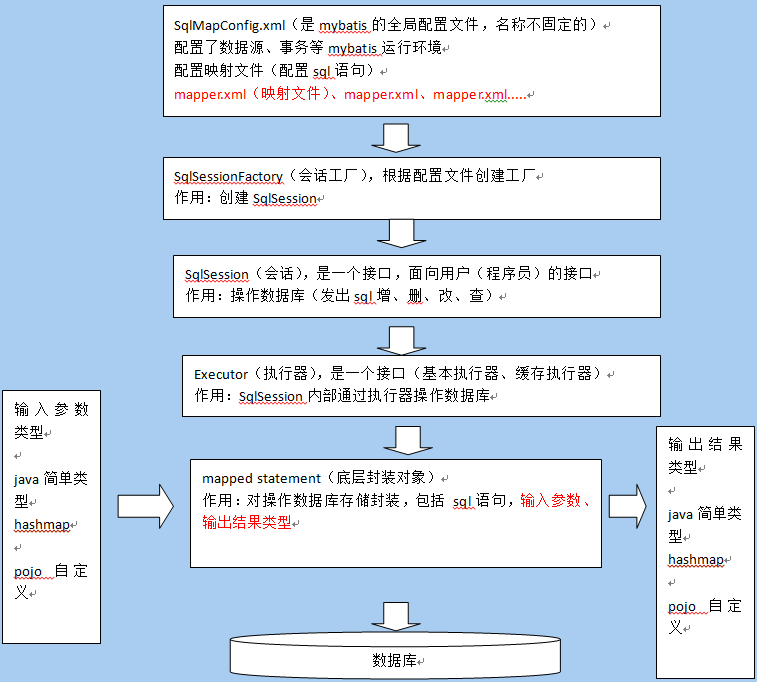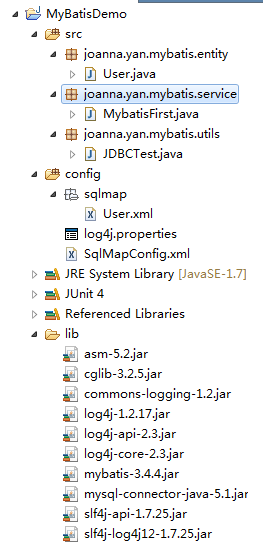原文地址:http://www.cnblogs.com/shanheyongmu/p/7120012.html
1.对原生态jdbc程序中问题总结
1.1 jdbc程序
需求:使用jdbc查询mysql数据库中用户表的记录
statement:向数据库中发送一个sql语句
预编译statement:好处:提高数据库性能。
预编译statement向数据库中发送一个sql语句,数据库编译sql语句,并把编译的结果保存在数据库砖的缓存中。下次再发sql时,如果sql相同,则不会再编译,直接使用缓存中的。
jdbc编程步骤:
1. 加载数据库驱动
2. 创建并获取数据库链接
3. 创建jdbc statement对象
4. 设置sql语句
5. 设置sql语句中的参数(使用preparedStatement)
6. 通过statement执行sql并获取结果
7. 对sql执行结果进行解析处理
8. 释放资源(resultSet、preparedstatement、connection)
public class JDBCTest {
public static void main(String[] args) {
Connection connection = null;
// 预编译的Statement,使用预编译的Statement提高数据库性能
PreparedStatement preparedStatement = null;
ResultSet resultSet = null;
try {
// 加载数据库驱动
Class.forName("com.mysql.jdbc.Driver");
// 通过驱动管理类获取数据库链接
connection = DriverManager.getConnection(
"jdbc:mysql://localhost:3306/mybatis?characterEncoding=utf-8",
"root", "root");
// 定义sql语句 ?表示占位符
String sql = "select * from t_user where username = ?";
//获取预处理statement
preparedStatement = connection.prepareStatement(sql);
// 设置参数,第一个参数为sql语句中参数的序号(从1开始),第二个参数为设置的参数值
preparedStatement.setString(1, "王五");
// 向数据库发出sql执行查询,查询出结果集
resultSet = preparedStatement.executeQuery();
// 遍历查询结果集
while (resultSet.next()) {
System.out.println(resultSet.getString("id") + " "+ resultSet.getString("username"));
}
} catch (Exception e) {
e.printStackTrace();
} finally {
//释放资源
if (resultSet != null) {
try {
resultSet.close();
} catch (SQLException e) {
e.printStackTrace();
}
}
if (preparedStatement != null) {
try {
preparedStatement.close();
} catch (SQLException e) {
e.printStackTrace();
}
}
if (connection != null) {
try {
connection.close();
} catch (SQLException e) {
e.printStackTrace();
}
}
}
}
}
1.2 问题总结
上面代码的问题总结:
1. 数据库连接,使用时就创建,不使用立即释放,对数据库进行频繁连接开启和关闭,造成数据库资源浪费,影响数据库性能。
解决方案:使用数据库连接池管理数据库连接。
2. 将sql语句硬编码到Java代码中,如果sql语句修。改,需要重新编译java代码,不利于系统维护。
解决方案:将sql语句配置在xml配置文件中,即使sql变化, 不需要对java代码进行重新编译。
3. 向preparedStatement中设置参数,对占位符位置和设置参数值,硬编码在Java代码中,不利于系统维护。
解决方案:将sql语句及占位符和参数全部配置在xml中。
4. 从resultSet中遍历结果集数据时,存在硬编码,将获取表的字段进行硬编码,不利于系统维护。
解决方案:将查询的结果集,自动映射成Java对象。
2.MyBatis框架
2.1MyBatis是什么?
MyBatis 本是apache的一个开源项目iBatis, 2010年这个项目由apache software foundation 迁移到了google code,并且改名为MyBatis,实质上Mybatis对ibatis进行一些改进。
MyBatis是一个优秀的持久层框架,它对jdbc的操作数据库的过程进行封装,使开发者只需要关注 SQL 本身,而不需要花费精力去处理例如注册驱动、创建connection、创建statement、手动设置参数、结果集检索等jdbc繁杂的过程代码。
Mybatis通过xml或注解的方式将要执行的各种statement(statement、preparedStatemnt、CallableStatement)配置起来,并通过java对象和statement中的sql进行映射生成最终执行的sql语句,最后由mybatis框架执行sql并将结果映射成java对象并返回。
2.2MyBatis框架

1. mybatis配置
SqlMapConfig.xml,此文件作为mybatis的全局配置文件,配置了mybatis的运行环境等信息。
mapper.xml文件即sql映射文件,文件中配置了操作数据库的sql语句。此文件需要在SqlMapConfig.xml中加载。
2. 通过mybatis环境等配置信息构造SqlSessionFactory即会话工厂
3. 由会话工厂创建sqlSession即会话,操作数据库需要通过sqlSession进行。
4. mybatis底层自定义了Executor执行器接口操作数据库,Executor接口有两个实现,一个是基本执行器、一个是缓存执行器。
5. Mapped Statement也是mybatis一个底层封装对象,它包装了mybatis配置信息及sql映射信息等。mapper.xml文件中一个sql对应一个Mapped Statement对象,sql的id即是Mapped statement的id。
6. Mapped Statement对sql执行输入参数进行定义,包括HashMap、基本类型、pojo,Executor通过Mapped Statement在执行sql前将输入的java对象映射至sql中,输入参数映射就是jdbc编程中对preparedStatement设置参数。
7. Mapped Statement对sql执行输出结果进行定义,包括HashMap、基本类型、pojo,Executor通过Mapped Statement在执行sql后将输出结果映射至java对象中,输出结果映射过程相当于jdbc编程中对结果的解析处理过程。
3.入门程序
3.1 需求
根据用户id(主键)查询用户信息
根据用户名称模糊查询用户信息
添加用户
删除用户
更新用户
3.2 所需jar包
MyBatis下载地址:https://github.com/mybatis/mybatis-3/releases
mybatis-3.4.4.jar :核心包
mysql-connector-java-5.1.jar:mysql的驱动包
3.3 工程结构

3.4 log4j.properties
# Global logging configuration #在开发的环境下,日志级别要设置成DEBUG,生产环境设置成info或error log4j.rootLogger=DEBUG, stdout # Console output... log4j.appender.stdout=org.apache.log4j.ConsoleAppender log4j.appender.stdout.layout=org.apache.log4j.PatternLayout log4j.appender.stdout.layout.ConversionPattern=%5p [%t] - %m%n
3.5 SqlMapConfig.xml
MyBatis核心配置文件,配置MyBatis的运行环境,数据源、事务等。
<?xml version="1.0" encoding="UTF-8" ?>
<!DOCTYPE configuration
PUBLIC "-//mybatis.org//DTD Config 3.0//EN"
"http://mybatis.org/dtd/mybatis-3-config.dtd">
<configuration>
<!-- 和spring整合后 environments配置将废除-->
<environments default="development">
<environment id="development">
<!-- 使用jdbc事务管理,事务控制由mybatis管理-->
<transactionManager type="JDBC" />
<!-- 数据库连接池,由mybatis管理-->
<dataSource type="POOLED">
<property name="driver" value="com.mysql.jdbc.Driver" />
<property name="url" value="jdbc:mysql://localhost:3306/mybatis?characterEncoding=utf-8" />
<property name="username" value="root" />
<property name="password" value="root" />
</dataSource>
</environment>
</environments>
<!-- 加载映射文件 -->
<mappers>
<mapper resource="sqlmap/User.xml"/>
</mappers>
</configuration>
3.6 根据用户id(主键)查询用户信息
3.6.1创建po类
 View Code
View Code3.6.2映射文件
映射文件命名:
User.xml(原始的ibatis的命名方式),mapper代理开发映射文件名称叫XXXMapper.xml,比如:UserMapper.xml、ItemsMapper.xml。
在映射文件中配置sql语句。
<?xml version="1.0" encoding="UTF-8"?>
<!DOCTYPE mapper
PUBLIC "-//mybatis.org//DTD Mapper 3.0//EN"
"http://mybatis.org/dtd/mybatis-3-mapper.dtd">
<!--namespace命名空间,作用就是对sql进行分类化的管理,理解为sql隔离
注意:使用mapper代理开发时,namespace有特殊作用 -->
<mapper namespace="test">
<!--在映射文件中配置很多sql语句 -->
<!--需求:通过id查询用户表的记录 -->
<!--id:标识映射文件中的sql,称为statement的id。将sql语句封装在mapperStatement的对象中,所有id称为Statement的id;
parameterType:指定输入参数的类型,这里指定int型;
#{}:表示一个占位符;
#{id}:其中id表示接收输入的参数,参数名称就是id,如果输入参数是简单类型,#{}中的参数名可以任意,可以是value或其它名称;
resultType:指定输出结果所映射的Java对象类型,select指定resultType表示将单条记录映射成Java对象。
-->
<select id="findUserById" parameterType="java.lang.Integer" resultType="joanna.yan.mybatis.entity.User">
select * from user where id=#{id}
</select>
</mapper>
3.6.3在SqlMapConfig.xml中加载映射文件
<!-- 加载映射文件 -->
<mappers>
<mapper resource="sqlmap/User.xml"/>
</mappers>
3.6.4程序编写
public class MybatisFirst {
@Test
public void findUserByIdTest(){
//mybatis的配置文件
String resource="SqlMapConfig.xml";
InputStream inputStream=null;
SqlSession sqlSession=null;
try {
inputStream=Resources.getResourceAsStream(resource);
//1.创建会话工厂,传入mybatis的配置文件信息
SqlSessionFactory factory=new SqlSessionFactoryBuilder().build(inputStream);
//2.通过工厂得到SqlSession
sqlSession=factory.openSession();
//3.通过SqlSession操作数据库
//参数一:映射文件中的statement的id,等于namespace+"."+statement的id;
//参数二:指定和映射文件中所匹配的parameterType类型的参数;
//sqlSession.selectOne结果是与映射文件所匹配的resultType类型的对象;
//selectOne:查询一条结果
User user=sqlSession.selectOne("test.findUserById", 1);
System.out.println(user.toString());
} catch (IOException e) {
e.printStackTrace();
}finally{
if(sqlSession!=null){
sqlSession.close();
}
if(inputStream!=null){
try {
inputStream.close();
} catch (IOException e) {
e.printStackTrace();
}
}
}
}
}
3.7根据用户名称模糊查询用户信息
3.7.1映射文件
使用User.xml,添加根据用户名称模糊查询用户信息的sql语句。
<!--
需求:根据用户名称模糊查询用户信息,可能返回多条数据
resultType:指定的就是单条记录所映射的Java类型;
${}:表示拼接sql字符串,将接收到的参数内容不加任何修饰的拼接在sql中。使用${}拼接sql,可能会引起sql注入;
${value}:接收输入参数的内容,如果传入的是简单类型,${}中只能使用value
-->
<select id="findUserByName" parameterType="java.lang.String" resultType="joanna.yan.mybatis.entity.User">
select * from user where username LIKE '%${value}%'
</select>
3.7.2程序编写
@Test
public void findUserByNameTest(){
//mybatis的配置文件
String resource="SqlMapConfig.xml";
InputStream inputStream=null;
SqlSession sqlSession=null;
try {
inputStream=Resources.getResourceAsStream(resource);
//1.创建会话工厂,传入mybatis的配置文件信息
SqlSessionFactory factory=new SqlSessionFactoryBuilder().build(inputStream);
//2.通过工厂得到SqlSession
sqlSession=factory.openSession();
//3.通过SqlSession操作数据库
//参数一:映射文件中的statement的id,等于namespace+"."+statement的id;
//参数二:指定和映射文件中所匹配的parameterType类型的参数;
//sqlSession.selectOne结果是与映射文件所匹配的resultType类型的对象;
//list中的user和resultType类型一致
List<User> list=sqlSession.selectList("test.findUserByName", "小明");
System.out.println(list);
} catch (IOException e) {
e.printStackTrace();
}finally{
if(sqlSession!=null){
sqlSession.close();
}
if(inputStream!=null){
try {
inputStream.close();
} catch (IOException e) {
e.printStackTrace();
}
}
}
}
3.8添加用户
3.8.1映射文件
在User.xml配置添加用户的statement(多个sql)。
<!--
需求:添加用户
parameterType:指定输入的参数类型是pojo(包括用户信息);
#{}:中指定pojo的属性名称,接收到pojo对象的属性值,mybatis通过ONGL(类似于struts2的OGNL)获取对象的属性值
-->
<insert id="insertUser" parameterType="joanna.yan.mybatis.entity.User">
insert into user (username,sex,address,birthday) values (#{username},#{sex},#{address},#{birthday})
</insert>
3.8.2程序编写
@Test
public void insertUserTest(){
//mybatis的配置文件
String resource="SqlMapConfig.xml";
InputStream inputStream=null;
SqlSession sqlSession=null;
try {
inputStream=Resources.getResourceAsStream(resource);
//1.创建会话工厂,传入mybatis的配置文件信息
SqlSessionFactory factory=new SqlSessionFactoryBuilder().build(inputStream);
//2.通过工厂得到SqlSession
sqlSession=factory.openSession();
User user=new User("yan",new Date(System.currentTimeMillis()),"女", "上海");
//3.通过SqlSession操作数据库
//参数一:映射文件中的statement的id,等于namespace+"."+statement的id;
//参数二:指定和映射文件中所匹配的parameterType类型的参数;
sqlSession.insert("test.insertUser",user);
//提交事务
sqlSession.commit();
System.out.println(user.getId());
} catch (IOException e) {
e.printStackTrace();
}finally{
if(sqlSession!=null){
sqlSession.close();
}
if(inputStream!=null){
try {
inputStream.close();
} catch (IOException e) {
e.printStackTrace();
}
}
}
}
3.8.3自增主键返回
mysql自增主键:执行insert提交之前自动生成一个自增主键。
通过Mysql函数获取到刚插入记录的自增主键:LAST_INSERT_ID()
是insert之后调用此函数。
修改insertUser定义:
<!--
需求:添加用户
parameterType:指定输入的参数类型是pojo(包括用户信息);
#{}:中指定pojo的属性名称,接收到pojo对象的属性值,mybatis通过ONGL(类似于struts2的OGNL)获取对象的属性值
-->
<insert id="insertUser" parameterType="joanna.yan.mybatis.entity.User">
<!-- 将insert插入的数据的主键返回到User对象中;
select last_insert_id():得到刚inser进去记录的主键值,只适用于自增主键;
keyProperty:将查询到的主键值,设置到parameterType指定的对象的那个属性;
order:select last_insert_id()的执行顺序,相对于insert语句来说它的执行顺序;
resultType:指定select last_insert_id()的结果类型;
-->
<selectKey keyProperty="id" order="AFTER" resultType="java.lang.Integer">
select last_insert_id()
</selectKey>
insert into user (username,sex,address,birthday) values (#{username},#{sex},#{address},#{birthday})
</insert>
3.8.4非自增主键返回(使用uuid())
使用mysql的uuid()函数生成主键,需要修改表中id字段类型为String,长度设置为35位。
执行思路:
先通过uuid()查询到主键,将主键输入到sql语句中。
执行uuid()语句顺序相对于insert语句之前执行。
<!--
需求:添加用户
parameterType:指定输入的参数类型是pojo(包括用户信息);
#{}:中指定pojo的属性名称,接收到pojo对象的属性值,mybatis通过ONGL(类似于struts2的OGNL)获取对象的属性值
-->
<insert id="insertUser" parameterType="joanna.yan.mybatis.entity.User"><!--
使用mysql的uuid(),实现非自增主键的返回;
执行过程:通过uuid()得到主键,将主键设置到user对象的id的属性中,其次,在inser执行时,从user对象中取出id属性值;
-->
<selectKey keyProperty="id" order="BEFORE" resultType="java.lang.String">
select uuid()
</selectKey>
insert into user (id,username,sex,address,birthday) values (#{id},#{username},#{sex},#{address},#{birthday})
</insert>
通过oracle的序列生成主键:
<selectKey keyProperty="id" order="BEFORE" resultType="java.lang.String">
SELECT 序列名.nextval()
</selectKey>
insert into user(id,username,birthday,sex,address) value(#{id},#{username},#{birthday},#{sex},#{address})
3.9删除用户和更新用户
3.9.1映射文件
<!-- 需求:删除用户 -->
<delete id="deleteUser" parameterType="java.lang.Integer">
delete from user where id=#{id}
</delete>
<!-- 需求:更新用户 注意:id必须存在 -->
<update id="updateUser" parameterType="joanna.yan.mybatis.entity.User">
update user set username=#{username},sex=#{sex},address=#{address},birthday=#{birthday} where id=#{id}
</update>
3.9.2程序编写
@Test
public void deleteUserTest(){
//mybatis的配置文件
String resource="SqlMapConfig.xml";
InputStream inputStream=null;
SqlSession sqlSession=null;
try {
inputStream=Resources.getResourceAsStream(resource);
//1.创建会话工厂,传入mybatis的配置文件信息
SqlSessionFactory factory=new SqlSessionFactoryBuilder().build(inputStream);
//2.通过工厂得到SqlSession
sqlSession=factory.openSession();
//3.通过SqlSession操作数据库
//参数一:映射文件中的statement的id,等于namespace+"."+statement的id;
//参数二:指定和映射文件中所匹配的parameterType类型的参数;
sqlSession.delete("test.deleteUser",3);
//提交事务
sqlSession.commit();
} catch (IOException e) {
e.printStackTrace();
}finally{
if(sqlSession!=null){
sqlSession.close();
}
if(inputStream!=null){
try {
inputStream.close();
} catch (IOException e) {
e.printStackTrace();
}
}
}
}
@Test
public void updateUserTest(){
//mybatis的配置文件
String resource="SqlMapConfig.xml";
InputStream inputStream=null;
SqlSession sqlSession=null;
try {
inputStream=Resources.getResourceAsStream(resource);
//1.创建会话工厂,传入mybatis的配置文件信息
SqlSessionFactory factory=new SqlSessionFactoryBuilder().build(inputStream);
//2.通过工厂得到SqlSession
sqlSession=factory.openSession();
User user=new User(2,"yan",new Date(System.currentTimeMillis()), "女", "上海");
//3.通过SqlSession操作数据库
//参数一:映射文件中的statement的id,等于namespace+"."+statement的id;
//参数二:指定和映射文件中所匹配的parameterType类型的参数;
//根据id更新用户
sqlSession.update("test.updateUser",user);
//提交事务
sqlSession.commit();
} catch (IOException e) {
e.printStackTrace();
}finally{
if(sqlSession!=null){
sqlSession.close();
}
if(inputStream!=null){
try {
inputStream.close();
} catch (IOException e) {
e.printStackTrace();
}
}
}
}
3.10 总结
3.10.1 parameterType
在映射文件中通过parameterType指定输入参数的类型。
3.10.2 resultType
在映射文件中通过resultType指定输出结果的类型
3.10.3 #{}和${}
#{}表示一个占位符,#{}接收输入参数。#{}可以有效防止sql注入。类型可以是简单类型,pojo、hashmap。如果接收简单类型,#{}中可以写成value或其它名称。
#{}接收pojo对象值,通过OGNL读取对象中的属性值,通过属性.属性.属性...的方式获取对象属性值。
${}表示一个拼接符号,拼接sql串,会引起sql注入存在安全隐患,所以不建议使用${}。${}接收输入参数,类型可以是简单类型,pojo、hashmap。如果接收简单类型,${}中只能写成value。
${}接收pojo对象值,通过OGNL读取对象中的属性值,通过属性.属性.属性...的方式获取对象属性值。
3.10.4 selectOne和selectList
selectOne查询一条记录,如果使用selectOne查询多条记录则抛出异常:
org.apache.ibatis.exceptions.TooManyResultsException: Expected one result (or null) to be returned by selectOne(), but found: 3
at org.apache.ibatis.session.defaults.DefaultSqlSession.selectOne(DefaultSqlSession.java:70)
selectList可以查询一条或多条记录。
3.11 MyBatis和Hibernate本质区别和应用场景
hibernate:是一个标准ORM框架(对象关系映射)。入门门槛较高,不需要程序员写sql,sql语句自动生成了。对sql语句进行优化、修改比较困难。
应用场景:
使用于需要变化不多的中小型项目,比如:后台管理系统,erp、orm、oa。。。
mybatis:专注是sql本身,需要程序员之家编写sql语句,sql修改、优化比较方便。mybatis是一个不完全的ORM框架,虽然程序员自己写sql,mybatis也可以实现映射(输入映射、输出映射)。
应用场景:
适用与需求变化较多的项目,比如:互联网项目。
第六周总结
第五周总结
第四周总结
第三周总结
第二周总结
第一周总结
《需求分析和系统设计》阅读笔记三
《需求分析和系统设计》阅读笔记二
Linux——error while loading shared libraries 的解决方法
